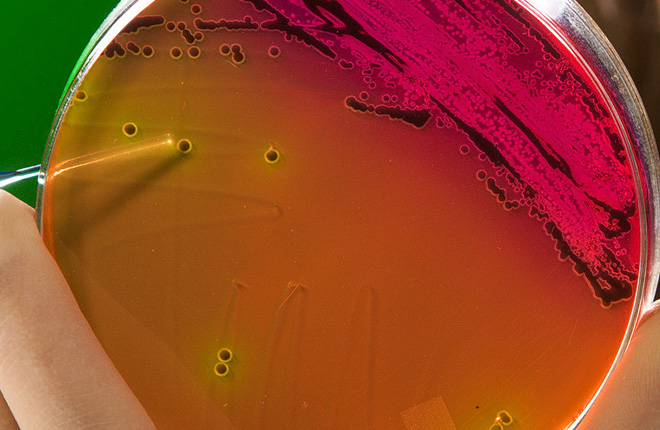ARS’s “One Health” Antibiotic Awareness
This month, ARS observes the 20th anniversary of the National Antimicrobial Resistance Monitoring System (NARMS), along with World Antibiotic Awareness Week and Get Smart about Antibiotics Week. Each year, more than 23,000 people in the United States die from antibiotic-resistant bacterial infections.
Overuse of antibiotics in humans and animals is a major factor leading to resistance development. That’s where NARMS comes into play. Since 1996, the group has provided key information about emerging bacterial resistance and led efforts to limit the spread of resistance.
USDA’s role in NARMS finds our department monitoring and analyzing changes in antibiotic resistance on farms and in food-processing plants.
|
|
USDA’s Food Safety and Inspection Service (FSIS) collects slaughterhouse samples and evaluates them for antibiotic resistance. Scientists with USDA’s Agricultural Research Service (ARS) investigate antibiotic resistance in animals, fish, water, air, soil, manure, and plants. ARS animal-health experts reduce drug resistance by developing antibiotic alternatives. ARS food-safety experts study bacterial resistance to antimicrobial agents used to protect the food chain. ARS engineers and microbiologists examine soil for antibiotic drug residue and for resistant bacteria and genes.
Steven Kappes, ARS’s Associate Administrator for National Programs, is the co-chair of USDA’s “One Health” Joint Working Group. The “One Health” approach embraces the idea that human, animal, and environmental health are critically interconnected and require a strong commitment across a wide variety of sectors and disciplines. Kappes characterizes our efforts like this: “Through public-private and interagency partnerships, ARS develops innovative alternatives to antibiotics, such as animal vaccines, enhancement of the immune system, and antibody therapies.”
Here are some examples of the important contributions ARS research is making toward reducing antibiotic resistance:
-
At the ARS Bacterial Epidemiology and Antimicrobial Resistance (BEAR) Unit in Athens, Georgia, scientists investigate the persistence and transfer of antibiotic-resistant bacteria and genes throughout agroecosystems (ecosystems managed for food and fiber production).
-
ARS researchers use advanced screening techniques to identify genes that allow microbes to resist antibiotic drugs and antimicrobial compounds. ARS shares this information with NARMS to support policymakers’ efforts to reduce medical antibiotic use as part of Federal efforts to slow the spread of antimicrobial resistance.
-
In 2016, ARS researchers at the Athens unit were the first in the United States to find a bacterial gene in livestock that causes resistance to the important antibiotic drug colistin. The resistance gene is on a plasmid—a piece of DNA that is separate from the bacterial strain’s chromosomal DNA. Plasmids are important because they can quickly and easily transfer genetic material from one bacterial type to another. ARS researchers screened more than 2,000 intestine samples from food-producing animals to find the gene.
-
-
In Fayetteville, Arkansas, ARS scientists patented and licensed a phage (a virus that naturally kills bacteria) that is currently used to reduce disease in millions of chickens. Targeted phages hold promise as alternatives to antibiotics and for use against multi-drug–resistant pathogens.
-
In College Station, Texas, ARS scientists developed a patented pre-harvest feed additive that, when given to livestock and poultry, significantly reduces postharvest Escherichia coli levels. ARS researchers at other locations are working to identify innate genetic markers that through conventional breeding methods will produce animals with enhanced immune systems.
-
In Maricopa, Arizona, ARS scientists are tracking antibiotics in treated wastewater and their uptake by plants after irrigation.
-
In Ames, Iowa, ARS researchers are using nucleic acid sequencing technology to study the effects on gut bacteria in animals that consume antibiotics in their feed.
-
Other examples of ARS’s antibiotic-resistance work include developing improved cattle-grazing strategies, improving farm-scale compost facilities, and investigating the airborne transport of antibiotic-resistant genes and bacteria from land-applied poultry litter.
ARS’s interdisciplinary approach strengthens the network of “One Health” efforts to develop and implement antimicrobial-resistance solutions for healthy people, healthy animals, and a healthy environment.—By Chavonda Jacobs-Young, Administrator, Agricultural Research Service.
“ARS’s 'One Health' Antibiotic Awareness" was published in the November 2016 issue of AgResearch Magazine.
Key Facts
- Antibiotic-resistant bacterial infections threaten human and animal health.
- The National Antimicrobial Resistance Monitoring System tracks emerging resistance.
- ARS plays a critical role by investigating antibiotic resistance in agricultural uses.
Full Story








